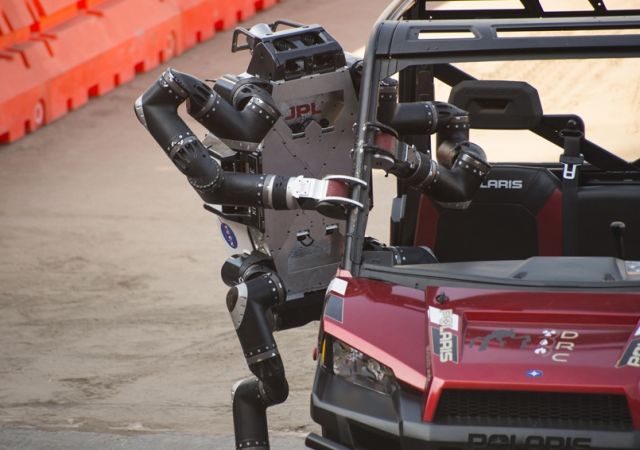The ICB's Katie Byl Takes 5th Place in DARPA's 2015 Robotic Challenge with RoboSimian

The spindly appearance of JPL's RoboSimian was somewhat unique among competitors in the DARPA challenge, as most were bipedal walkers. Here RoboSimian exits its vehicle following a brief drive through a slalom course at the DARPA Robotics Challenge Finals.
Katie Byl’s UCSB robotics team in collaboration with researchers from Caltech and NASA’s Jet Propulsion Laboratory at Caltech, came in fifth out of 23 teams from across the country and around the globe in the Defense Advanced Research Projects Agency’s (DARPA) Robotics Challenge Finals on June 5th and 6th in Pomona, California.
“I’m really happy with how we did,” said Byl. “JPL designed and built RoboSimian, and my students — Brian Satzinger and Chelsea Lau — and I at UCSB have been helping JPL to write the software to control how the robot moves for the DARPA Robotics Challenge.”
The DARPA contest was launched in response to a humanitarian need that became glaringly clear during the nuclear disaster at Fukushima, Japan, in 2011. The challenge consisted of three increasingly demanding competitions over two years. The goal was to accelerate progress in robotics and hasten the day when robots have sufficient dexterity and robustness to enter areas too dangerous for humans and mitigate the impacts of natural or man-made disasters.
The competitors had to figure out how to get their robots (most of them upright and bipedal) to:
- Drive a vehicle through a slalom course and then exit the vehicle
- Open a door
- Turn a wheel to open a valve
- Cut a hole in a half-inch-thick panel of drywall using a cordless power drill
- Cross a field of debris or walk over uneven terrain
- Walk up a set of stairs
RoboSimian was one of only two robots (the other one is called CHIMP) that didn’t require human intervention to reset during either day of competition. The most common failure mode for other robots was falling down.
“RoboSimian has a phenomenal track record,” said Byl, whose research focuses on robot agility, reliability and response in variable conditions. “It’s fallen down maybe once in the past year of testing.” Even the creators of the winning robot, a humanoid designed by the Korea Advanced Institute of Science and Technology, had to take advantage of the grace period built into the competition that allows the robots’ handlers to reset their machines on the first day of testing.
“We’re really excited about the idea of continuing to work with RoboSimian,” said Byl. “It’s really interesting to think about the idea of having a robot where the same limbs can be used as arms or legs.” Future efforts may concentrate on refining the robot’s sense of balance, enabling more autonomous mobility in complex environments, and reducing time delays during teleoperation.
Jet Propulsion Laboratory news article
UCSB Current: Future Simian
